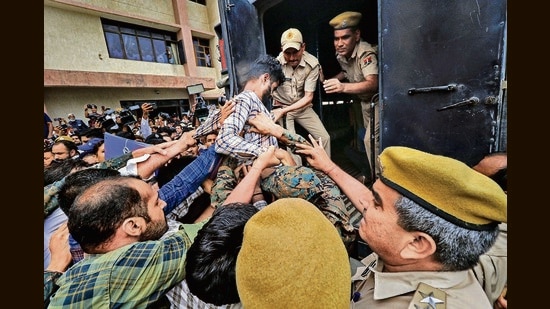Islamic radicalisation has hurt the moderates
There are Barelvis who say that the DEI is aping Tablighi Jamat and radicalising Sufis, which is bad. The challenge for the security agencies is figuring out how far the DEI preachers may have penetrated the original Barelvis in India
The horrendous murder carried out in Islamic State-style in Udaipur last week is shocking for its mediaeval brutality. But that is not the only reason why it stands out. It is no small development that the act was committed by two followers of the Barelvi or Sufi or dargah-worshipping Muslims, long seen as moderate as compared to the Wahabis — represented by Deoband school, its missionary wing, Tablighi Jamaat, and Tanzim Ahle Hadis (a doctrine followed by the Lashkar-e-Taiba) — who are seen as votaries of radical Islam. It underlines that radicalisation of a section of Muslim youth is rising even in a comparatively moderate section of the Sunni Muslim community, in the form of Barelvis.

It is true that there are hardly any major terror outfits, even in Pakistan, born from the Barelvi sect. A handful were raised in Pakistan to oppose the violence of radical Deobandi outfits. Even in the 2006 and 2008 bomb blasts across India, Indian Muslims involved were almost all followers of Wahabi Tanzims — Deoband-Tablighi and Ahle Hadis. But radicalism in Barelvi Muslims was introduced in the early 1980s when Maulana Iliyas Attar Kadri, a Memon Muslim preacher of the Barelvi sect originally from Kutiyana near Mahatma Gandhi’s birthplace, Porbandar, launched the Dawat-e-Islami (DEI) in Karachi to fight rising Deobandi aggression and violence against the Barelvi sect. The Deobandis would snatch the control of Sufi mosques, which has been taking place on a large scale in India too, and is a major point of confrontation between the Sufis and Wahabis.
The ideological differences between the Barelvis and Wahabis are unbridgeable, save the momentary unity when Muslims are under attack. The Barelvis contend that a believer cannot reach out to Allah without the spiritual support and blessing of the saints, and, therefore, worship at the dargahs of Sufi saints. It also gives space to a syncretic tradition that kept Muslims and Hindus close, as the latter too worshipped at these dargahs.
In contrast, the Wahabis believe that the worship of saints is un-Islamic, drawn from the guru-puja tradition of the Hindus, and there is no place for it in Islam, which supports direct interaction with Allah. The differences are so deep that they often lead to conflict in India. In Pakistan, it snowballs into violence with Deobandi terror outfits often blowing up dargahs. It was with a view to counter the growing influence of Wahhabism that Iliyas Attar Kadri floated the DEI, which preaches religious aggression to Sufi youth to prevent them from converting to Wahhabism. The core of this DEI stance in Pakistan was an emphasis on Sharia and strong opposition to repealing or diluting blasphemy laws.
Interestingly, the DEI is fashioned almost after its rival, Tablighi Jamat. Its followers are supposed to go on preaching expeditions and work for the brotherhood of Sufi Muslims. However, the emphasis on the importance of Prophet Mohammed is more among the DEI’s followers, and, therefore, any objectionable comment invites a deeper reaction.
The first manifestation of the radicalisation of Sufism came when Malik Mumtaz Kadri, the personal bodyguard of then Pakistan Punjab governor Salman Taseer, shot him dead in 2011 for speaking against the blasphemy law of Pakistan, and later hundreds of thousands of Barelvi followers hit the streets in support of blasphemy laws. The beheading of tailor Kanhaiya Lal by two Barelvi men, Gaus Mohammed and Riyaz Akhtari, one of whom allegedly went to the DEI headquarters in Pakistan in 2014, is the second such instance, and suggests that that Islamic radicalism has entered the Sufis, though its magnitude in Sufis is much lower than among the Wahabis.
Incidentally, Iliyas Attar Kadri has been opposed to the Pakistan army’s support to Deobandis, but has refrained from resorting to violence to counter Deobandi violence, at least on paper. However, his follower Saleem Kadri (who was killed by the Jaish-e-Mohammed in Pakistan in 2001 ) floated the Sunni Tehreek, which had no qualms about resorting to violence to counter Deobandi aggression. The Salman Taseer episode happened in Pakistan. But the killing of Kanhaiya Lal occurred in India. This should set off alarm bells in our security agencies as the two killers followed a religious ideology long believed to be moderate. To be sure, there are Barelvis who say that the DEI is aping Tablighi Jamat and radicalising Sufis, which is bad. The challenge for the security agencies is figuring out how far the DEI preachers may have penetrated the original Barelvis in India.
Uday Mahurkar is a central information commissioner, journalist and author
The views expressed are personal
Continue reading with HT Premium Subscription




